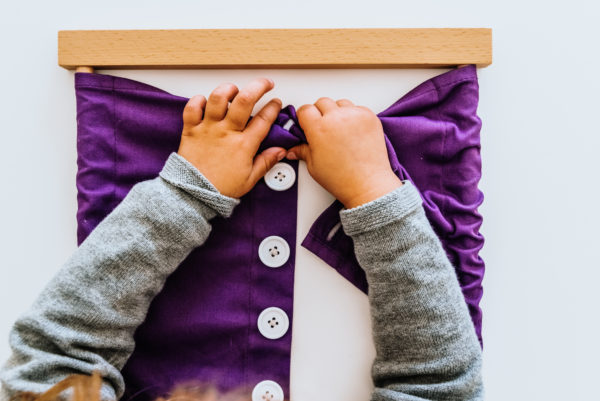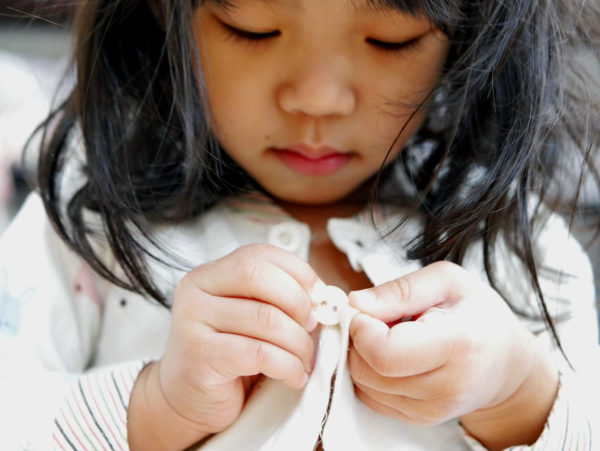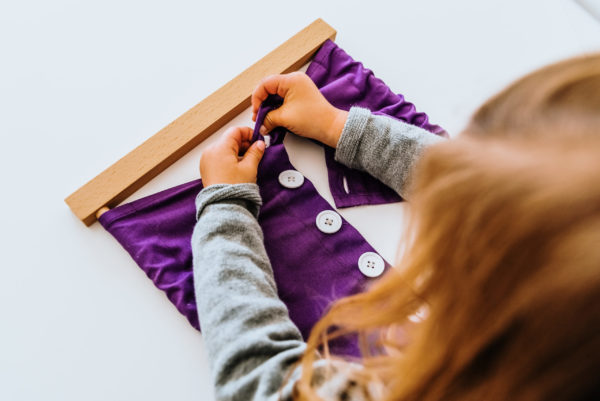The Montessori Button Frame
So, the other day I was buttoning my son's shirt (2.5) and he asked if he could do it himself. Up until this moment, he showed no interest in dressing himself, no less buttoning his whole shirt! So, I thought to myself…”He's ready. It's time for some Montessori Primary Activities. We'll start with Montessori Button Frame!” It turns out I was spot-on!
This was one of my daughter's favorite, and most helpful, Montessori Dressing Frames.
Montessori Dressing Frames really are the heart of Montessori.
Without the independence these materials help provide, it's difficult for children to gain the confidence they need to perform the essential task of everyday life; getting dressed.
Many may look at these activities and materials and think, “Let kids be kids! Why the rush?“. Well, these activities do not aim to rush children into anything.
In fact, Practical Life Activities give children the freedom to do things they are already capable of or have the desire to be capable of.
Helping children learn how to care for themselves is essential to building independence and self-esteem.

In addition, activities such as the Button Frame, help a child develop coordination, sense of order, and concentration.
You just might notice that helping a child master self-care activities, such as buttoning their own clothes, will curb their frustration and make everyone's day go a bit smoother!
So, onto the Montessori Dressing Frames!
Sweaters, pajamas, and many other items require the skill of buttoning.
So, out of all the Montessori Dressing Frames, the Button Frame would be the first on my list to present!

The Button Frames in Montessori have two overlapping pieces of fabric; buttons on one side and button holes on the other.
How to introduce the Montessori Button Frame
Here is how to present this material:
- The button Frame should be positioned with the buttons to your child's right-hand side with the button holes to the right
- Tell your child that you are going to unbutton and button the frame
- Work from the top to the bottom of the frame
- Grasp the right side of the button with your right thumb and index finger.
- Grasp the material directly to the left side of the button with your left thumb and index finger.
- Slowly pull the material to the left to expose the hole.
- Slide the button from the hole.
- Pause for a moment to let your child see that the button has been released.
- Lay the fabric back down on the released button and repeat these steps with the remaining buttons.
- Open the right flap of fabric fully, then the left and close them; left first, then right.
- After all the buttons are released, re-button the frame using the same technique, making sure to pause to allow your child to see when each button has been pulled fully through each hole.
The basic idea is to move slowly and methodically to show your child how to do this activity.
Your child will want to practice on their own and you will find they quickly carry this new skill into their daily lives, practicing buttoning their own clothes.

Please keep in mind that you can do preschool at home and present these materials in a variation that works for your family! It doesn't have to be a formal presentation, nor do you have to spend money on it!
Here is a link to instructions on how to make your own Button Frame.
We have a 13-month-old that makes Montessori presentations a little more challenging, but still totally doable!
Take advantage of naptimes, downtime, and free-times!
Cheers and don't forget to subscribe!

Pingback: What is the Absorbent Mind? — The Montessori-Minded Mom
My daughter is very left-handed (it’s been clear since she was only a few months old). Should I present this material the same way, or reverse the direction so she can use her dominant hand for the manipulation?
Great question! Yes, when the child is left-handed, you set the activity up with the child’s dominant hand in mind. This can mean sitting to your child’s left instead of right when demonstrating it. You should also demonstrate the activity using your left hand, which might take a little practice if you are right-handed.
It might be helpful to let your child manipulate the button frame for a minute or two before you present the activity. This way you can be sure which hand they will use as dominant. My left-handed 4 year old does not use his left hand as dominant for every activity.
I hope this helps.